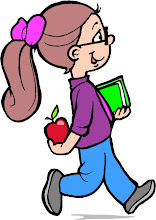We are reading one Nature Friend magazine each week. I read most of the articles to K., but on Monday I have her look through the magazine and place sticky notes on the three articles she wants to read. Two of them she reads aloud. On Friday she reads the last one silently and then I ask her four or five questions about it.
Also on Friday she chooses a topic to learn more about. After the first week, I learned to be more general. For instance, we aren't going to find books about harlequin ducks at the library, but we will find books about ducks. I show her the list of general subjects and have her number her first, second, and third choices. Then we go to the library website and find the catalog numbers for them. That way when we go to the library we are ready to find the books and don't have to mess with their computers, which sometimes aren't working. K. is learning how to find books using the Dewey Decimal System.
The first week she wanted to read more about comets.
The second week she chose owls.
The third week she chose whales.
The fourth week she chose birds.
Each magazine has a few activities (word search, crossword, etc.) that we do as we come to them. I put a plastic transparent sheet over the page (hold it still with sticky notes) and use a water base marker to write our answers. This way we can pass the magazines on to friends and they can do the activities, too.
Over the planning week she will do a project. I had planned on her doing one of the subjects she had chosen, but she wanted to do dolphins, so I decided that her being excited about learning was more important than my plan. This project will be a poster. After reading some books about dolphins, she will write things she learned on the poster and add pictures. (This is actually an assignment in our grammar book.)
